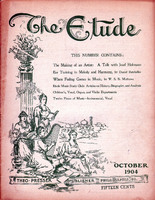There are several drawbacks in 3 and 4 manual organs as ordinarily specified. One is the great waste in the duplication of string-tone stops, which do not materially add to the full-organ tone. We have the Swell Viol di Gamba and Æoline, the Great Gamba and Dolce, and the Choir Viol d’Amour and Dulciana—6 stops where two would suffice, if always available for the same purpose. Another defect is the full-organ tone, the prime desideratum, which is generally bad owing to lack of Open Diapason tone, and predominance of reeds, mixtures, and 2-feet stops. The use of Diapasons on high pressure wind gives the full-organ tone a hard, forced character, quite inferior to that soft, deep, rich body which is due to a number of Open Diapasons and a large amount of 8-feet flue-work on low-pressure wind.
Another inconvenience comes from changing from accompaniment stops to solo stops on the same manual, with the necessary pedal-coupling changes. Still another arises from the fact that the accompaniment to the solo stop is not in the same swell-box, and always keeping the relative balance of power, when the swell is opened or shut. Sometimes the accompaniment is too loud, and sometimes too soft, never properly supporting the varying power of the solo.
Besides there is the question of expense. Two-thirds of the cost goes in action and wind chests, and sometimes, with 4-manual organs, three-quarters. So that, of $10,000, say, only $2500 goes into pipes. Eight and 4-feet pedal stops, too, are unnecessary, With a pedal scale of 42 notes, the pedal at octaves, will give all the full scale 8-feet tone needed, while the Unison Separation converts any 16-feet pedal stop into an 8-feet one of full 30-note scale, at half the cost. Pedal reeds are discordant, and are only rarely of use.
The following specification is an attempt to remedy all of these drawbacks, and to give, in a 2-manual pneumatic organ of 25 speaking stops, the effect of a 4-manual organ of 44 stops, at half the cost. Pneumatic thumb pistons take the place of the extra manuals, and act more quickly. There are 5 of these on the Swell, and 8 on the Great, 4 for harmony and 4 for solo tone. All the solo stops are on the Great manual and all of the accompanying stops are on the Swell. So that all solo tone-qualities are ready, by means of the pistons, without change of manual or couplers. There are only 2 manual wind- chests, which are on the same level, placed contiguously, and end on, with each rank of pipes extending toward the back of the organ, not from side to side. The Swell-box extends partly over the Great wind chest, and all of the solo stops, except the clarinet, are inclosed in it. The tuner’s aisle plank has 2 reed stops on each side of it. The Swell Vox Humana is on the extreme left of the Swell, and the Great clarinet on the extreme right of the Great wind chest. Ample 2- and 4-feet effect comes from the Swell Super Octave coupler. All of the stop-knobs are on the left hand side of the manuals, none on the right.
GREAT.
1. Double op. diap.
2. Op. diap. (1).
3. Op. diap. (2).
4. Op. diap. (3).
5. Clarinet.
IN SWELL-BOX.
6. Doppel flute.
7. Bourdon.
8. Harm. flute.
9. Piccolo.
10. Oboe.
11. Cornopean.
12. Krummhorn.
13. Orch. oboe.
SWELL.
14. Op. diap.
15. Viol di gamba.
16. St. diap.
17. Clarabella.
18. Æoline.
19. Celeste.
20. Principal.
IN ECHO-BOX.
21. Quintadena.
22. Vox humana.
PEDAL
23. Op. diap. (wood), 42.
24. Op. diap. (metal), 42.
25. Violone (borrowed from 11).
26. Bourdon, 42.
27. Lieblich gedact (borrowed from 7).
Usual couplers, subs and supers, and combination pedals.—T. G. Jeffers. Mus. Bac.



